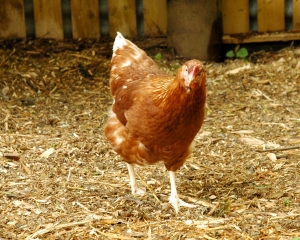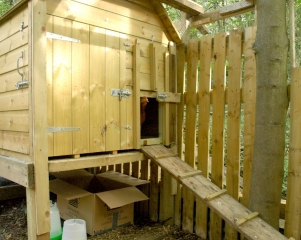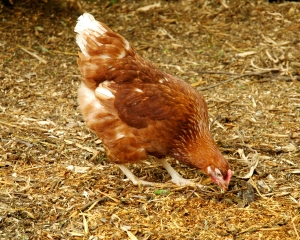Economics of having chickens: getting started
After 18 months of waiting, we *finally* got some chickens on Tuesday. This post is the first in what I imagine will be an occasional series about the economics of having chickens.
Despite my tight-fisted frugal heart, having chickens at home isn’t about getting cheap eggs. It’s about getting good eggs from well treated and well fed chickens. It’s about food metres and not food miles. It’s about using up an otherwise hard to make productive bit of ground. It’s about introducing more diversity into our garden and harvesting poop for fertiliser. And it’s about living with some fascinating pseudo-dinosaurs – learning about them, looking after them and laughing at them because they’re such fun, odd things. But while those things are almost priceless, they do have a price.
Back when I first got giddy about the idea of having chickens, I read a great page about the economics of having chickens – breaking it down to the cost per egg over the first year (when there are higher capital costs but potentially high egg production) and in future years (smaller capital cost, slowing egg production etc). It was great – but can I find it now? No. I hate Google sometimes. But I’m going to work out something similar for myself and this post is the first stage of that.
Capital outlay
We’ve spent quite a bit upfront – way more than necessary in some ways.
The biggest expense was the coop. We looked into building our own but we’ve been so busy with everything, it would never have happened. I looked around on the second-hand market for coops but couldn’t find anything suitable – they were either too small, too big or too expensive for what they were. So we bought a ready-made one from a local-ish woodworker. We got the Ellerton at £359 and I’m going to review it as a choice once we see how the chickens settle in. We could have certainly made one for cheaper but we went for it for three reasons:
- Compared to others on the market, it seemed like a good compromise on size, quality and price.
- It looked pretty. Not a minor point given it’s a focal point of our garden and our neighbours look out over it too.
- Based on the second-hand coops I saw, if we keep it in good condition (which we should do to maximise its lifespan), we should be able to sell it on for a reasonable price if we upsize/downsize/realise we hate chickens.
Around the coop is the run, which John’s dad built. As he’s retired, his labour is free to us, save the cost of a few drinks/snacks throughout the day and he’s a great recycler so he used salvaged wood for most of the structure, scavenged paving stones for other bits and some of the wire came from another job. Most of the wire though was brought new, and so was some of the wood. He had also previous fenced around the whole enclosure with new-bought wood.
We also had one-off expenses for a feeder & drinker (again, we could have made them ourselves but we got good ones so they we’ve got should last for years) – and for the chickens themselves. Since last winter, the plan had been that we’d get some chickens for free – that John’s brother had hand-raised then given to our friend to foster until we were ready for them (which turned out to be a lot longer than originally planned). Two of those turned out to be boys and we killed & butchered them in April, and the friend & his children bonded with the rest so we said they could keep them. Anyway, we ended up having to buy the chickens and at their most expensive stage, point of lay. As I said yesterday, we’ll be able to take advantage of the existing chickens to raise hatching eggs/chicks in the future though so hopefully we won’t have to shell out (…pun not intended) for more fully grown chickens in the future.
Total capital costs = £359+£48+£23+run = about £550
Ongoing costs
The biggest ongoing cost is going to be food. We’re going to feed them a combination of layers’ pellets and “free” food – kitchen scraps, cheap veg grown especially for them, foraged stuff & insects. We’ve also got some mixed corn as a treat. The pellets and corn both cost around £8 for a 20kg bag – it’s hard to say how long that’ll last us though – obviously the more “free” food I can give them, the further the bought food will stretch, so we’ll see.
The “free” food will hopefully improve their diets as well as reducing our food bill. I’m going to use spare patches of bed/containers to grow cheap & easy greens for them – they’ve already got some bolting lettuces and radishes to start on. Seeds are trivially cheap and I’m already doing the labour growing other veg for us to eat. I also hope to collect snacks from the woods for them – edible wild plants, acorns (when they’re in season) and there has even been talk of bringing woodlice-filled logs into the run to provide them with free protein.
They also need a supply of grit. I got a 5kg bag with the food (cost = £2) and I’ll bake & crush up their egg shells to supplement it and keep their calcium levels topped up — my most favourite recycling reuse ever ;)
Other things they’ll need regularly: other dietary supplements as required (poultry spice, apple cider vinegar etc); hay/straw for the nest boxes; wood shavings or the like for the floor; mite/louse powder; other medicines as needed (maybe wormers, antibiotics if they get ill)… yes, I’ve a feeling it’s a good job we’re not doing this for cheap eggs!
We’ve had three eggs so far which, by my reckoning, is just under £200 an egg. There is a little of already familiar squawking going on right now so that might be number 4 – taking it down to a bargainacious £150 an egg! ;)
One Comment
Join the conversation and post a comment.
Trackbacks/Pingbacks
- Growing vegetables for chickens | The Really Good Life - [...] I mentioned in my post about the economics of getting started with chickens, we’re hoping to feed the chickens…








Raising your own chicken is such a fun thing to do. I have thought about keeping chickens when I was still a child since we had a small farm before and he had chickens, goats and a dog. Right now I have 6 laying hens and I get around 4-5 fresh eggs every day. I like to see doing taking a sand bath. You are 100% sure that you are eating fresh eggs.